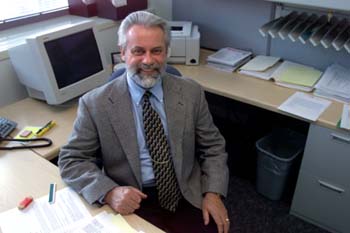
Dr. Friedrich Schuening says the new, less-intensive bone marrow transplant approach may be ideal for older or more fragile patients.(photo by Dana Johnson)
New technique may widen bone marrow transplant patient base
A new, less-intensive approach to bone marrow transplantation may make the potentially life-saving treatment an option for older or more fragile patients, Vanderbilt-Ingram Cancer Center doctors say.
Vanderbilt-Ingram recently began offering the approach, which is called a “mini-transplant” because it uses a less intensive regimen to prepare the body for the transplant. Traditional transplants are preceded by total body irradiation and high-dose chemotherapy to kill the malignancy and to make room for the donor marrow to “graft” or take hold. However, the radiation and chemotherapy also effectively kill the patient’s immune system, leaving him or her open to infection and other potentially deadly complications.
“It’s a very exciting approach that may be ideal for patients who are not candidates for the high-dose conditioning treatment because of advanced age or pre-existing organ damage to the lungs, heart, kidneys or liver,” said Dr. Friedrich Schuening, Ingram Professor of Cancer Research and director of Vanderbilt-Ingram’s Stem Cell Transplant Program.
The bone marrow is the spongy tissue inside the hollow bones. It produces stem cells, which give rise to all the blood cells of the body — red cells which carry oxygen, the various white cells which fight infection, and platelets, which are responsible for clotting. Several malignancies involve these cells, including leukemias and lymphomas.
In a bone marrow (stem cell) transplant, the patient’s diseased marrow is wiped out and replaced with healthy stem cells from a donor. Stem cell transplants have also been used after treating patients with certain solid tumors, such as breast cancer, with high dose chemotherapy. These transplants are often referred to as “stem cell rescue” because the patient would otherwise die from the high dose chemotherapy.
While stem cell transplants have been successful in treating leukemias and lymphomas for many patients, only younger and otherwise healthy patients typically have qualified because of the intensity of the conditioning treatment.
The mini-transplant combines a lower-dose of radiation with new immuno-suppressive drugs that help prevent the patient’s own immune system from attacking and killing the donor cells. The approach also relies on what’s called “graft versus tumor” effect to help eliminate the malignancy. This is when the new donor stem cells recognize the tumor cells as foreign and mount a fierce immune attack.
If evidence of malignancy remains or if total “graftment” of the donor cells has not taken place about two months after transplant, additional donor lymphocytes will be infused as a “booster.”
While patients are still at risk for “graft versus host” disease — where the donor cells attack the patient’s own organs — the risk for other serious and potentially deadly complications, including infection and organ damage, appear to be greatly reduced, Schuening said.
The mini-transplant approach is offered at only a handful of cancer centers across the country and still considered investigational. Dr. Ted Arrowsmith is principal investigator of Vanderbilt-Ingram’s protocol, which has been approved by the medical center’s Institutional Review Board. The IRB is oversees all studies involving human subjects.
The initial diseases that will be treated at Vanderbilt-Ingram using the mini-transplant include chronic myelogenous leukemia, chronic lymphocytic leukemia, multiple myeloma (which tends to carry a high mortality rate with traditional high-dose conditioning regimens), certain types of non-Hodgkin’s and Hodgkin’s lymphoma, as well as sickle cell anemia.
“In the future, this approach might be applied to some solid tumors that appear most likely to respond to a graft versus tumor effect, including melanoma, renal cell carcinoma, cervical cancer and prostate cancer,” Schuening said. “We need more long-term data, but overall, this approach looks very encouraging.”













